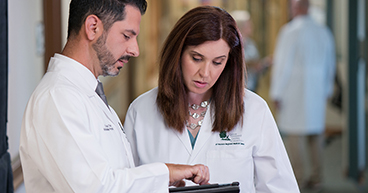
Twice a week, Suzi Kochar, MD, gets up extra early to see patients battling thyroid cancer at our hospital near Chicago. But Dr. Kochar is an endocrinologist a time zone away at our hospital near Phoenix. She doesn't hop on a plane and fly 1,800 miles to the Midwest. Dr. Kochar stays in Arizona and sees patients by video conference, a rapidly growing practice called telemedicine. "It's the future of medicine, I think," she says. Dr. Kochar's patients report to a special room outfitted with high-definition video equipment. A nurse is there to make sure the equipment is working and that the patient is seated in the right spot. When Dr. Kochar fires up her laptop, she and her patient are instantly connected.
Ramping up telemedicine programs
Multiple surveys show patients are increasingly comfortable with a virtual doctor visit, and health care providers are ramping up telemedicine programs to accommodate the demand. "Telemedicine is not a distant possibility; it is here and in play now," a 2014 report on a survey of health care executives asserts. According to the report, 90 percent of health care leaders say their organizations have or are establishing telemedicine programs. A 2013 study by the tech firm Cisco Systems found that 70 percent of patients are comfortable communicating with doctors via texting, email or video. And, according to a report by the analytics firm HIS Technology, the number of patients using remote medical services is projected to increase to 7 million in 2018, up from 350,000 in 2013.
Telemedicine is not just for the benefit of patients in America or other first-world countries. It is also being used to deliver health care to remote corners of the world stricken by extreme poverty or ravaged by war or that may not otherwise have access to doctors. Doctors in the United Kingdom are offering virtual visits to patients in remote villages in Zambia, where health care workers are scarce. American doctors are consulting with their counterparts at field hospitals in Syria to treat victims of that nation's civil war. Here at home, telemedicine gives patients immediate access to more doctors in multiple disciplines. It allows health care providers to reach more patients. And, in many cases, it's simply more convenient. "It increases patients' access to providers without the hassle of traveling or possibly waiting a long time for an appointment," Dr. Kochar says.
Growing acceptance
Patients at Midwestern may see a variety of other doctors and clinicians, such a medical oncologist and/or surgical oncologist to treat their cancer. Dr. Kochar may consult with a patient about an upcoming thyroid surgery that will be performed by doctors at Midwestern. Patients may also see Dr. Kochar after surgery to discuss treatment options, such as thyroid hormone replacement. Despite the growing acceptance to telemedicine, Dr. Kochar says some patients may be wary about seeing a doctor who is in a room hundreds of miles away. That trepidation often fades quickly, she says. "During the first visit, they will be a little intimidated because they are on a video conference," Dr. Kochar says. "But once we start talking, they feel more comfortable. I take a good amount of time during the interview, and by the end of the visit, they are fine."
Learn the difference between genetics and genomics.



